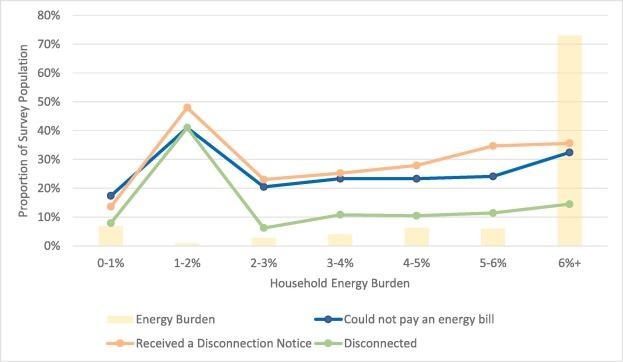Household energy use for services such as cooking1 or space heating and cooling2 is crucial for decent living conditions3. Unaffordable energy is a persistent trend4 that is negatively related to social cohesion, climate change responses, and disproportionate environmental impacts on low-income populations and minority groups5. Furthermore, energy inequity is not just a lack of money to meet basic energy needs—it is a lack of access to the capabilities6 that enable a sustainable and prosperous society built on just principles7. Energy inequity could have significant implications for navigating sustainable development and meeting societal goals around decarbonization and energy use. In this study, we demonstrate the magnitude of energy inequity in the United States (US) using a metric informed by Net Energy Analysis (NEA). Without a set of inclusive indicators and data tools to examine energy inequity, many households that are at risk of energy poverty and injustice may remain unidentified. This analysis applies lessons from NEA to address energy poverty in the US.
Many frameworks are currently being explored to understand energy poverty and equity, while differentiating between related concepts. In a thematic exploration of energy equity, Brown et al. identify energy access, energy poverty, energy insecurity, and energy burden as key concepts for understanding the issue8, but quantitative measurement of these concepts has been limited. Pachauri & Rao establish measures for the sustainable development context that incorporate periods when energy is available, the quality of voltage supplied, the reliability in terms of the number of disruptions, the capacity in terms of power available, the consumption levels allowed per day, and affordability of the standard consumption package as a percentage of household income9. Energy metrics have been assessed quantitatively across several countries. Though some aspects, such as formal disconnections from energy service10, are translatable to the US context, these methods require normalizing many variables amongst different types of data and are overly broad for applications in areas where electricity access is relatively high and reliable.
Of such areas, the United Kingdom (UK) has a richer history of incorporating energy poverty formally into its government programs: since 2000, the UK has used some form of an energy burden metric to assess whether households are facing energy poverty and determine the level of support that they require as a result11. This metric has evolved from a simple ratio of household income and energy expenditures to one that incorporates building efficiency ratings and average incomes in the community. While the European Union (EU) currently lacks a unified metric for energy poverty, similar metrics have been developed in member countries, such as a metric which compares incomes and expenditures to local averages and absolute heating needs to determine energy poverty levels in Italy12 or a multidimensional index of building quality and ability to pay bills in Poland13.

Prior research of household prosperity in limited global jurisdictions using these sorts of measures has found that gender, age, housing age14, tenure type15, energy inefficiency16, education, employment17, geography18, socioeconomic status19, race/ethnicity20, and macroeconomic conditions21 are associated with high energy burdens in various geographical areas. The US lags in part due to a lack of metrics and tracking, and this paper develops a tool to show how net energy is a valuable resource to evaluate energy burden and inequality.
In the US, energy inequity is a significant challenge as families struggle to meet monthly bills and live paycheck to paycheck11. There is a growing disparity between wealthier and lower-income households based on their abilities to meet basic energy needs8. While per-unit residential energy prices have increased below the rate of inflation in the US since the 1980s22, many households still struggle to make utility bill payments and are especially vulnerable to economic shocks21.
Ross and Drehobl performed distinct urban16 and rural14 analyses to describe energy inequity in the US. While limited by geographic and demographic focus and a lack of peer-review, these studies have established the proportion of income (G) spent on energy expenditures (S), or energy burden (Eb), as the standard benchmark for energy poverty in the US today (Eq. 1). The US Department of Energy (DOE) significantly improved upon Ross and Drehobl’s underlying methodology by assembling its Low-Income Energy Affordability Dataset (LEAD)23, which estimates incomes and energy expenditures for most households in the US at a census-tract scale.
$${{{{{\rm{Energy}}}}}}\,{{{{{\rm{Burden}}}}}}\,({E}_{b})=\frac{S}{G}$$(1)NEA offers potential support to understanding energy equity through the use of formally defined Energy Return Ratios (ERRs) like Eb that articulate the relationships among energy flows within complex systems24. Net Energy Return (NER), which describes the newly released potential to do work as a result of some activity, is recommended as a basis for future analysis25, especially in the study of macro-energy systems like the US residential housing stock26.
Here, we examine the relationship between energy spending and household energy income and observe spatial disparities across a census-tract scale—particularly across race and ethnicity, income, housing tenure, and educational attainment. A difference of $500 in annual energy expenditures dramatically improves many middle and high-income households’ ability to enjoy benefits from energy services for low cost (2–5% of annual income), but basic energy expenditures comprise approximately 14% of annual earnings for low-income households. The categorizations for federal assistance programs that are based on poverty line indices fail to capture at least 5.3 million households that would benefit from energy support and assistance. Households in communities of color experience energy poverty at a rate 60% greater than those in white communities based on this study. Additionally, state-level analysis demonstrates wider spatial disparities across states such as Maine, where residential heating oil and fuelwood remain common heat energy sources and states such as Alabama and Mississippi which have among the lowest net energy returns on average. This empirical analysis fills a gap in the current discussion about energy equity by providing a framework to evaluate disparities and include more households in energy poverty metrics that are aligned with the assessment of energy flows through biological, physical, and economic systems.









